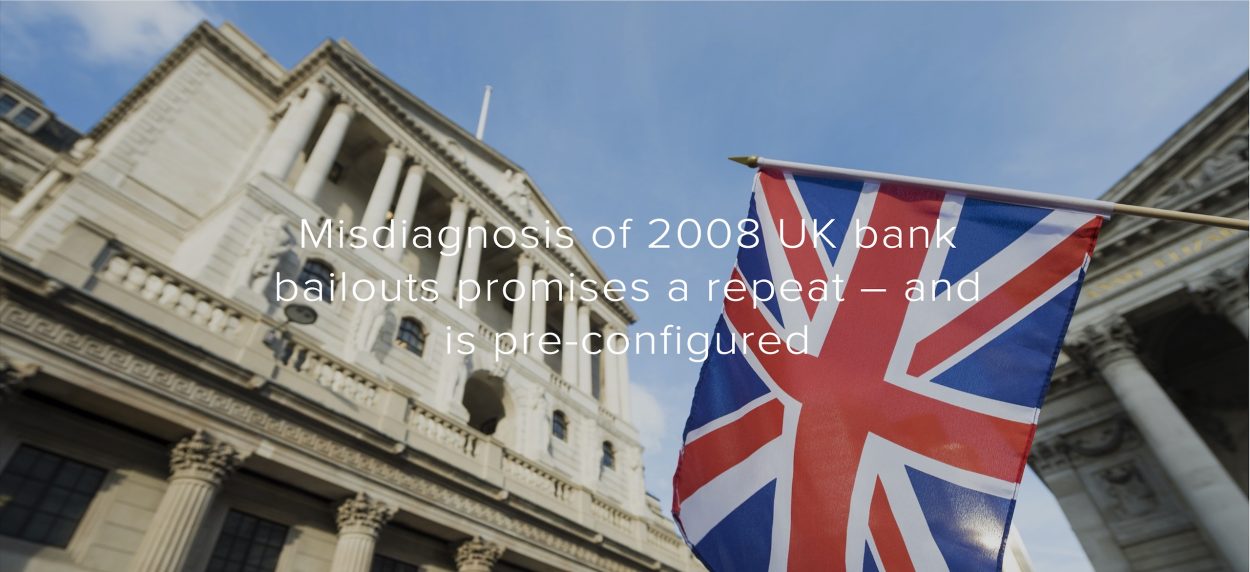Never again should the taxpayer bail out any banks
After the 2008 UK bank bailouts during the Global Financial Crisis (GFC) we were assured that the taxpayer would never again be called upon to support ailing banks and bankers. Committees of the Great and the Good[1]accepted the narrative that the GFC was attributable to excessive risk- taking in investment and international banking i.e. it was largely a foreign problem with an epicentre in the City of London due to its status as a global financial hub.
In the major UK banks the culpable activities were duly separated into different banks, with the safe, domestic business ‘ringfenced’ into a different bank, each one a Little Britain,[2] entire of itself.[3] Domestic-only neo-banks were licensed.[4] New risk-management metrics were applied, devised through the Bank for International Settlements in Basel, ostensibly requiring banks to hold more and higher-quality capital – Common Equity Tier 1 or CET1 – as a cushion against losses.[5] According to the Bank of England our banks are much more resilient than they were in 2008, with so-called CET1 Ratios in double figures.[6]
Misdiagnosis
What will now come to be realized is that the Great and the Good misdiagnosed how the GFC played out in the UK.They accepted a politically convenient narrative, one concocted by the liberal left for consumption by the liberal left, and overlooked the real one, to our collective and current peril.
Whatever happened in the US and the rest of the world during the GFC, the organizations that went under here in the UK, aside from Royal Bank of Scotland Group, were Halifax Bank of Scotland (which took Lloyds Banking Group down with it), Northern Rock, Bradford & Bingley, Alliance & Leicester, and Britannia (from the Potteries).
These were provincial, secondary banks, headquartered in Labour-voting areas and mostly former building societies freed from the restraints of mutuality. They indulged in excessive real estate lending into the UK rust belt (Labour-voting areas again). Didn’t New Labour love them! Breaking the cycle of boom and bust! Making new buildings shoot up where Margaret Thatcher’s tenure had left empty space. Provincial lenders showing dramatic growth compared to the stick-in-the-muds in the City of London…until it all went wrong and New Labour did the following:
- elevatedRoyalBankofScotlandGrouptotheleveloftheexemplarofthebankingindustry’s ills;
- consequentiallyplacedtheblameontheCityofLondon,oratleastonsupposedCityof London practices, even if carried out in Scotland,[7] Amsterdam,[8] or Stamford Connecticu;t[9] and,
- followedtheUS/restoftheworldnarrativebecauseitexculpatedthemfromtheirshareof the blame, given that New Labour had been in power for 10 years.This narrative was wrongly accepted by those charged with making sure it never happened again. There was no proper Truth Commission, and the processes that were undertaken used the accepted and politically convenient narrative as their kicking-off point instead of using the real one. Needless to say, though, this narrative accorded completely with that of Michel Barnier, then at the European Commission.This has left the UK financial system as weak now as it was then, and exposed to exactly the same risks.
UK banks are badly under-capitalized and mortgage lending is backed by very little capital at all
The UK banks have very thin capital. Professor David Blake – in his recent article ‘The Great Game Will Never End: Why the Global Financial Crisis Is Bound to Be Repeated’ – has shown that the five largest UK banks had CET1 at the end of 2016 of only 4% of their on-balance sheet assets: £205 billion of CET1 and £5 trillion of assets.[10]
The Bank of England nevertheless declares the UK’s banks to be resilient. This is because resilience is measured not with reference to the face value of either the bank’s on-balance sheet assets or its off-balance sheet contracts, but to their ‘risk-adjusted’ value – the bank’s Risk- Weighted Assets.[11] ‘Risk-Weighting’ is achieved by applying the BIS-devised Advanced Internal Ratings-Based methodology, which diminishes the face value of business by 65-75% in order to ascertain its Risk-Weighted Asset equivalent. The Risk-Weighted Assets act as the denominator and CET1 as the numerator in the CET1 Ratio, the Bank of England’s measure of resilience.
Mortgage lending is subject to particularly extreme diminution from its face value to its Risk- Weighted Asset equivalent. Mortgage lending is concentrated in ‘ringfenced banks’, the neo-banks and of course the unreconstructed building societies.
Current dangers in the UK – house price crash and taxpayers on the hook
We now have the same environmental conditions as existed in the UK before the GFC: elevated house prices and irresponsible lenders throwing money in at the top of the market and at a high loan-to-value ratio.
We have five new factors that combine to cause the taxpayer to be even more directly exposed than last time:
1. The Financial Services Compensation Scheme (FSCS): HM Treasury, through the FSCS, is obligated to repay depositors up to £85,000 each in relation to most accounts in most UK banks, where a bank goes into ‘resolution’;
2. ‘Resolution’, as opposed to bankruptcy or negotiated taxpayer bailout, is the way in which failed banks will be dealt with, meaning the government – thanks to its payouts under the FSCS – will become the main creditor of the ‘resolved’ bank;
3. Ringfencing: FSCS cover applies to the ‘ringfenced’ side of the largest UK banks, which is where the portfolio of mortgage loans is held;
4. FSCS cover applies to the neo-banks, some of which have been the most aggressive ones in building up their portfolios of mortgage loans, as well as to the unreconstructed building societies, who continue to be major market actors in mortgage lending; and,
5. the Bank of England supports the mortgage market by either buying Collateralized Loan Obligations backed by mortgage loans into its Quantitative Easing programme or by accepting them as security for its lending to banks.
How the taxpayer will bail out ‘ringfenced’ banks, neo-banks and building societies
Under the combination of ‘resolution’ and the operation of the Financial Services Compensation Scheme, the eligible depositors in a failed bank are paid out. The FSCS lacks the resources to pay out the depositors of a sizeable bank. The scheme is no more than a conduit to HM Treasury, who would have to issue new government bonds to raise the money to pay depositors, increasing the national debt.
The taxpayer thus becomes the replacement creditor for the depositors whom the FSCS has paid out. The FSCS and the way a resolution is carried out pre-configure the taxpayer as the supplier of bailout funds for UK banks (what we were told would not happen again).
How the Bank of England makes a loss and how the taxpayer covers that
The Bank of England has become a major player in the UK mortgage market, providing funding to whichever institution is making the original loan in two ways. Firstly, by making a loan to the institution that is secured by the pledging of Collateralized Loan Obligations. Secondly by buying Collateralized Loan Obligations into its Quantitative Easing programme.
These Collateralized Loan Obligations (CLOs) are collateralized by mortgage loans. Their structuring is identical to, and in fact they are, Residential Mortgage-Backed Securities, the type of financial instrument at the epicentre of the GFC. (italicised)
The Bank of England itself need have no concerns if it makes losses: it has a reinsurance policy with HM Treasury under which it can claim the lost amounts. HM Treasury will issue new government bonds in order to meet the losses and reimburse the Bank of England. It is the taxpayer that will be ultimately responsible for making the Bank of England good.
Conclusion – taxpayer bailout mechanisms are ready-to-roll
The new bailout mechanisms for the UK banking system and the Bank of England, required if house prices now crash, are already in place. They will not need to be hammered out in the early hours with curry brought in to HM Treasury from the Kennington Tandoori to sustain the weary negotiators. Losses suffered by the Bank of England will automatically be passed to taxpayers through HM Treasury. HM Treasury will be left as the main creditor of failed banks. Both actions will necessitate the issuance of yet more government bonds, for the repayment of which the taxpayer is responsible.
This is what happens when politically convenient explanations for disasters are accepted at face value, and when the diagnosis of and solution to a problem are delegated from one part of the left- liberal ‘nomenklatura’ that runs the UK to another: they apportion the blame to the political right – calling it ‘capitalism’ and ‘market failure’– whilst finding themselves guiltless.[12]
Bob Lyddon is an experienced management consultant both privately and with PwC, with a specialization in banking and payments. He has published numerous papers about the financial mechanisms of the EU, through the Bruges Group, Politeia and Global Britain.
[1] E.g. The Vickers Committee and ‘Changing Banking for Good’ [2] David Walliams and Matt Lucas, BBC, 2003-7
[3] John Donne: ‘No man is an island’
[4] Examples would be Atom Bank, Monzo, Starling, OakNorth
[5] The BIS is the forum of the major central banks, in which the Basel capital adequacy and liquidity regimes are devised. The BIS has defined Common Equity Tier 1 as a bank’s share capital and reserves, the type of equity that cannot be varied or paid out
[6] A bank’s CET1 Ratio is its CET1 divided by its Risk-Weighted Assets, which are calculated through BIS methodologies. The minimum threshold is 8%
[7] Gogarburn, near Edinburgh, RBS Group’s main office
[8] Headquarters of ABN-Amro Group, from whom RBS Group inherited a large portfolio of
Residential Mortgage-Backed Securities
[9] Headquarters of Greenwich Capital, RBS’ in-house market actor in Residential Mortgage- Backed Securities
[10] ‘The Great Game Will Never End: Why the Global Financial Crisis Is Bound to Be Repeated’, Journal of Risk and Financial Management, by Professor David Blake, Finance Faculty, Bayes Business School, City University of London, with substantial input from Professor Kevin Dowd of Durham University: The article is available through this link: https://www.mdpi.com/1911- 8074/15/6/245p. 13
[11] Off-balance sheet contracts would include derivatives. These contracts are also converted into Risk-Weighted Assets using the BIS-devised AIRB methodology
[12] Nomenklatura – a term from the Soviet Union where positions of responsibility were occupied by Communist Party members without reference to their credentials in the sphere of activity concerned.
Bob Lyddon
22 August 2022

